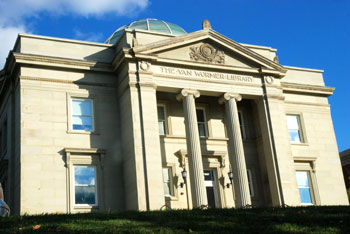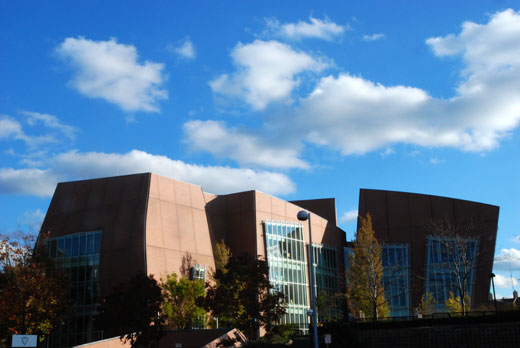
Universities are the perfect breeding grounds for revolutionary ideas that become medical and technological advancements. They have experienced researchers and teachers, and a continual infusion of new ideas from incoming students. Existing and start-up businesses across Northern Kentucky and Cincinnati are looking for innovations to help them excel and know researchers have the necessary expertise. This relationship fueled technology transfers.
With technology transfers (or tech transfers), universities and their faculties create research breakthroughs, and then work with existing or start-up businesses to bring the practical applications to the world. In essence, it is pairing the people with the ideas with the resources to bring the ideas to life—creating synergy.
Three local powerhouses—Northern Kentucky University, The University of Cincinnati and Cincy Tech—are working together to enhance our community and the world through tech transfers. Their success is keeping Cincinnati at the forefront of business and academics.
Tech Transfers from the Outside In
While UC and Cincy Tech may focus on research and licensing, NKU focuses on finding the right businesses for the practical applications. Jan W. Hillard, Ph.D. is NKU’s Associate Provost for Regional Stewardship. NKU performs a flywheel function within the community that supports the growth of tech transfers. Hillard says the flywheel function focuses on applied research, the value of good data and creative, actionable solutions.
 Hillard relates that his group specializes in “deeply profiling medium and large businesses” in manufacturing, information technology and related industries, advanced logistics and healthcare. They also partner with regional initiatives, like Vision 2015 and Tri-ED, whose goal is to ensure economic competitiveness and prosperity.
Hillard relates that his group specializes in “deeply profiling medium and large businesses” in manufacturing, information technology and related industries, advanced logistics and healthcare. They also partner with regional initiatives, like Vision 2015 and Tri-ED, whose goal is to ensure economic competitiveness and prosperity.
Through their Launchpad Program, NKU targets companies in the key sectors, collects data, and then completes an extensive interview with the CEO. Throughout the process, their goal is to assemble regional knowledge and business intelligence. In turn, this knowledge is passed along to Vision 2015, Tri-ED and other local partners.
“Launchpad is a major tool for NKU to identify technology development opportunities from the outside in,” Hillard says. “Applied research leads to tech transfers. But, you need to have the data profiling the company to find the right complement.”
This work ensures businesses can capitalize on the research, and the research finds the right partner. NKU can also facilitate success through suggestions for structural or procedural changes to improve the company’s process and help them stay competitive—this can be in response to the company’s own request or from results of NKU’s profiles.
 “When we understand business’ portfolio, we can better direct the region’s response,” Hillard notes.
“When we understand business’ portfolio, we can better direct the region’s response,” Hillard notes.
He further explains NKU’s unique position to assist initiatives, businesses and other universities. “NKU is all about regional stewardship. We want to make sure there is a bridge between businesses and universities to create synergies and help valuable technologies succeed.”
Cincinnati continues to be a regional and world leader in innovation thanks to UC, Cincy Tech and NKU. Tech transfers help ensure local businesses stay competitive through homegrown ingenuity, and foster successful relationships between companies and academic institutions.
Ideas that Benefit Everyone
 While universities and researchers have worked with local businesses for decades, the creation of the Bayh-Doyle congressional act in 1980 spurred the current tech transfer phenomenon. The Bayh-Doyle Act created a universal patent policy that allows non-profits and small businesses to retain the title to any inventions under federally funded research programs.
While universities and researchers have worked with local businesses for decades, the creation of the Bayh-Doyle congressional act in 1980 spurred the current tech transfer phenomenon. The Bayh-Doyle Act created a universal patent policy that allows non-profits and small businesses to retain the title to any inventions under federally funded research programs.
“The formation of the Bayh-Doyle offered a big opportunity for universities to invent and own the intellectual property (of the research outcome),” Ellen Monson, Ph.D., says. Monson is UC’s Director of Technology Transfer and Commercialization in the Intellectual Property Office.
She notes that while there are some obligations that are part of being a federally funded program, it is not the only motivation. “Universities are responsible to their communities to facilitate tech transfers for the overall public good.”
 Although programs may approach it differently, the principle is basically the same across the nation. Either a professor/researcher will develop an idea and bring it to the university, who will then license it to a business. Or, a company will come to the university with an idea they would like to test or develop in the academic world before funding practical applications.
Although programs may approach it differently, the principle is basically the same across the nation. Either a professor/researcher will develop an idea and bring it to the university, who will then license it to a business. Or, a company will come to the university with an idea they would like to test or develop in the academic world before funding practical applications.
Not only is the business benefiting, it also helps the school generate income. This revenue in turn betters the university and what it can offer its students.
For example, during Fiscal Year 2002 to Fiscal Year 2008 UC has:
• Reported 692 inventions
• Filed 338 patent applications (78 patents were issued)
• Had 135 deals (Option, Licenses, Evaluations, Assignments, Amendments)
• Generated $11,178,867 of royalty
• Seen 9 start-up activities
But more than just making money, the universities are contributing vital and life-altering advancements. For example, UC’s accomplishments have dated back as far as George Rieveschl’s creation of Benadryl in 1940, Albert Sabin’s Polio Live Virus-Vaccine in 1950, and the more recent Cardiolite technology. (Cardiolite is a cardiovascular imaging agent that gives doctors a noninvasive way to distinguish between functional and nonfunctional heart tissue.)
Writer: Bethe Ferguson
Photography by Scott Beseler
Solar Decathlon House on UC's campus
Solar panels on the Decathlon House
The Vontz Center for Molecular Studies
University of Cincinnati
Lab photo provided by the University of Cincinnati
Enjoy this story?
Sign up for free solutions-based reporting in your inbox each week.